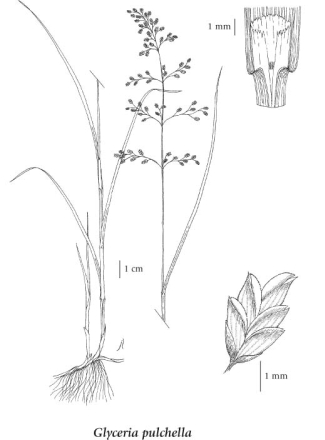Glyceria pulchella (Nash) K. Schum.
slender mannagrass (MacKenzie Valley mannagrass)
Poaceae (Grass family)
Introduction to Vascular Plants
slender mannagrass (MacKenzie Valley mannagrass)
Poaceae (Grass family)
Introduction to Vascular Plants
Species Information
General:
Perennial grass from rhizomes, often rooting at the lower nodes; stems erect, 40-100 cm tall.
Leaves:
Sheaths rough, the hairs angled backwards, open at least near the tops; blades 2-5 mm wide, flat, minutely rough on both surfaces; ligules (1.5) 2-4 mm long.
Flowers:
Inflorescence a loose panicle 15-25 cm long or more, the branches ascending to spreading-ascending; spikelets mostly 3- to 6-flowered, egg-shaped to cylindrical, compressed, 3.5-6 mm long; lower glumes 1.5-2 mm long, the upper ones 2-2.3 mm long; lemmas 1.6-2.2 mm long, prominently 7-nerved, the nerves finely rough; stamens 3; anthers about 0.6 mm long.
Illustration

If more than one illustration is available for a species (e.g., separate illustrations were provided for two subspecies) then links to the separate images will be provided below. Note that individual subspecies or varietal illustrations are not always available.
Illustration Source: The Illustrated Flora of British Columbia
Ecology
Ecological Framework for Glyceria pulchella
The table below shows the species-specific information calculated from
original data (BEC database) provided by the BC Ministry of Forests and Range.
(Updated August, 2013)
The table below shows the species-specific information calculated from
original data (BEC database) provided by the BC Ministry of Forests and Range.
(Updated August, 2013)
| Site Information |
Value / Class |
||
|
Avg |
Min |
Max |
|
| Elevation
(metres) |
1067 | 455 | 2039 |
| Slope
Gradient (%) |
0 | 0 | 3 |
|
Aspect (degrees) |
200 | 135 | 265 |
| Soil
Moisture Regime (SMR) [0 - very xeric; 4 - mesic; 8 - hydric] |
6 | 5 | 7 |
| Modal
Nutrient Regime
Class |
D | ||
| #
of field plots species was recorded in: |
7 | ||
| Modal
BEC Zone Class |
BWBS | ||
|
All BEC Zones (# of stations/zone) species was recorded in |
BWBS(2), ESSF(1), SBPS(2) | ||
|
Source:
Klinkenberg 2013
|
|||